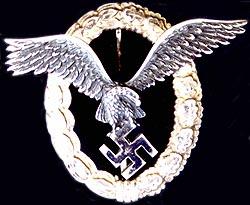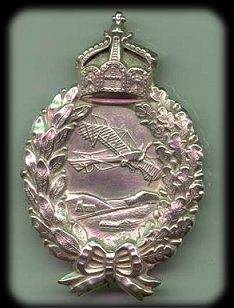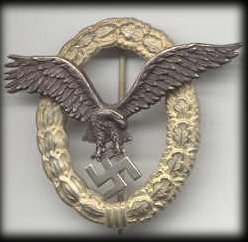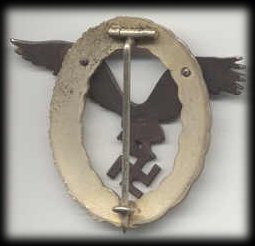
By LCR Andrew Hopkins
The pilot badge was instituted on august,12, 1935 by order of Reichsmarchall Hermann Göring (references are found in the ‘’Luftwaffen Verordnungsblatt’’ of may, 23, 1935).
|
|
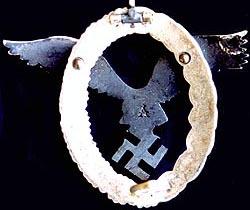 |
Design
The pilot badge takes the form of a massive swooping eagle clutching a mobile swastika in it’s talons. The eagle is superimposed on a wreath of half laurel (left) and half oak leaves (right). The wreath imagery is carried over from the Imperial flight badge series. The Luftwaffe pilot badge portrays an image of unbridled aggression and ferocity.
Materials, Construction and Finish
As with most Third Reich items, the pilot badge can be found in materials of different quality. Aluminum, nickel-silver, plated tombak, plated alloy and lacquered zinc were all used. Pre and early war versions tend to be executed in high quality nickel and tombak, while the mid to late war pieces tend to be of the alloy and zinc variety. Aluminum was used in the late 1930’s, but was rather quickly deemed unsuitable. Original aluminum badges are prized for their rarity and pristine finish. Pin assemblies are normally nickel or nickel plated tombak on earlier badges. Later types often have pins and hinges made of steel or alloy.
The eagle and wreath are struck from an appropriate metal and always display good detail. Many early and high quality versions are made using a technique called die forging, which involves metal stock being heated until red hot and malleable. Theraw material is then struckwith an open die under tons of pressure. The resulting image is then removed and cooled. This process creates intricate patterns and multi-dimensional designs without undue wear on the toolings. The result is a crisp, detailed image with quite prominent die strike lines. The cooling process often renders small fissures in the image known as “cold shunts”. The fissures look like tiny folds or cracks and are often only apparent under magnification. The components are hand finished, which can render a slightly different outline to badges by the same maker. This feature is most obvious in the wingtip feathers, talon/swastika area and wreath.
All pilot badges, even those made of inferior materials, are of a multi-piece, two rivet construction. The size and shape of the rivets vary with the maker and quality of the badge. High quality versions tend to have small, symmetrical precision rivets. Cheaper types use larger button rivets or even ones that are “squashed” into place. The high quality product of one maker, Gebruder Wegerhoff of Ludenscheid (GWL), has countersunk rivets with a tiny hollow “divet” in the center. A feature to look for on higher quality pilot badges is the presence of solder neatly built up around the base of the rivet where it attaches to the back of the eagle. This was often done to stabilize the rivet and give a better surface for riveting. This is a quality touch not normally found on restrikes and reproductions.
High quality pilot badges are almost always found with neatly soldered barrel hinges and catches formed from stout wire. The catches are neatly finished on the free end and are soldered directly to the wreath. Again, high quality GWL badges are a notable exception. They have small block hinges and catches that look like a tiny claw. Cheaper pilot badges often have hinges and catches attached with soldering plates of various designs. This technique was used to expand the surface area of the soldering point on components made of inferior, lead based alloys. The pin on virtually all original pilot badges is the needle type. On hi0gh quality versions, it is soldered directly into the barrel hinge, while on cheaper versions it can be found looped through the hinge in a shepherd’s crook shape. The tip of the pin is normally pointed or finished in a dome-like shape.
Regardless of quality, the pilot badge is always finished with a dark, oxidized eagle and silver wreath. On high quality badges made of nickel silver or nickel silver plated tombak, the eagle is chemically darkened and the wreath is chemically frosted in a matte silver. The highlights of the wreath are often burnished to a shine, leaving the frosting behind in the recessed areas. The result is an exceptionally attractive badge with a pronounced three dimensional look. Cheaper badges use thin plating and lacquer washes to achieve the appropriate colors. These badges, while acceptable products, pale in comparison to their high quality counterparts.
Dimensions
The specifications* for the pilot badge were mandated upon it’s creation in 1936. They are:
- Wingspan of eagle: 65mm
- Height (and width) of swastika: 15-16mm
- Thickness of eagle: 2.5mm
- Width of wreath:42mm
- Height of wreath:53mm
- Thickness of wreath:2.5mm
*These dimensions vary slightly from badge to badge and maker to maker.
Specific Makers
The pilot badge was produced in comparatively large numbers by many different firms. I have geared my comments toward the more attractive and collector-desirable high quality badges. As the quality of materials declined, most makers tended to continue using the same dies in conjunction with cheaper pins and finishes.
Some of the more commonly encountered or desirable types are:
C.E. Juncker
Juncker badges are arguably the best, and certainly one of the most desirable pilot badges. The early high quality versions can be found in two distinct patterns. The first, produced from 1936 to approximately 1939, has a very flat eagle and thinner wreath. The space between the eagle’s legs is often pierced in order to give a three dimensional look. The second pattern has a more massive eagle and thicker wreath. The second pattern is the most commonly encountered high quality Juncker pilot badge. Both styles have small, neatly finished dome rivets that often include a small flat spot on the top. These rivets also frequently have a dark copper color on badges that were worn. The hinges are of the barrel variety and typically measurein the neighborhood of 13.2 mm. The catches are formed from thick round stock and are soldered directly to the wreath. When worn, the hinges and catches display the same copper color found on the rivets. The finish of original high quality Juncker badges is exceptionally fine and delicate. The darkening of the eagle looks almost like the bluing on a gun as opposed to the thick, black oxide finish of other makers. Similarly, the silver frosting on the wreath is very thin and subject to wear. It is difficult to find an original Juncker pilot badge with all of it’s finish intact!
Juncker pilot badges are almost always marked in one of two ways. The first version is the letters “CEJ” inside a rectangle. This is the earlier mark and is only found on the first pattern badge. The second marking is:
C.E. Juncker
Berlin SW
Note the full stop periods after the C. and E., but not after the S and W. Also, the Juncker maker stamp uses distinctive stylized lettering that make the various strokes look almost like tiny triangles. This is especially noticeable in the “L” of Berlin.
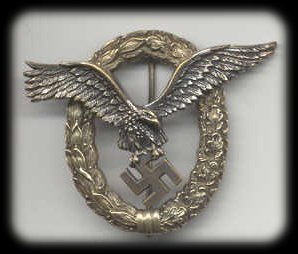
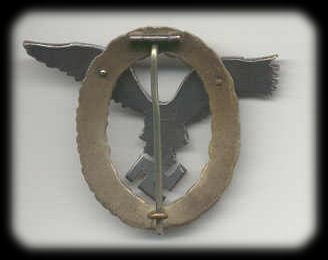
High quality Juncker badges have a look and feel that is unmistakable. This goes for all of their high quality badges in the aircrew series. Once you’ve handled and really examined an original, you will never be fooled by a fake. The C.E. Juncker firm was the Tiffany and Company of German badge production. Consequently, Juncker badges look more like high quality jewelry than pieces of military insignia.
Note: Juncker also produced the very first pattern of aircrew badge. This piece has a horizontally oval wreath and a large gangly looking eagle. Because it is actually the precursor of the Combined Pilot Observer badge, it will not be covered.
J(I)MME
The Berlin firm of IMME , often written JMME in keeping with the German practice of switching these two letters, also made very high quality pilot badges. Their products are virtually identical in pattern to the C.E. Juncker pilot badge. The construction is somewhat different in that the eagle is more vaulted and the wreath has a slightly more vaulted, thinner profile. JMME rivets are very tiny, and their high quality products have barrel hinges, needle pins and thick wire catches.
JMME badges have a very thick, frosty silver finish on the wreath and an oxidized eagle that is finished a bit like a Juncker. Their badges are typically marked “JMME” or “JMME & (u) Sohn Berlin”. Original JMME badges are very high quality articles.
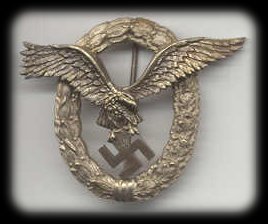
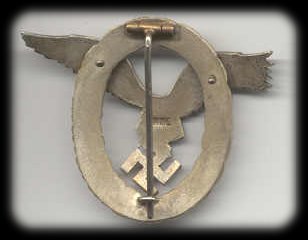
Wilhelm Deumer
Like JMME products, the pilot badges made by the Wilhelm Deumer firm of Ludenscheid look very much like those of C.E. Juncker. The distinguishing feature of a Deumer badge is a thicker, more durable finish and a tiny hand done cut out between the legs. High quality versions have barrel hinges, needle pins and wire catches. Again, high quality is the key. These badges are normally marked :
W. Deumer
Ludenscheid
Gebruder Schneider, Wein (BSW)
The Austrian firm of BSW made unique and particularly attractive pilot badges. Sometimes called “squat eagles”, they have a small, delicate look. Assembled with tiny precision rivets, BSWs also have a long narrow barrel hinge and a very different catch. Formed from a piece of stout wire, the catch is neatly soldered into the wreath at a right angle. BSW badges have a shiny silver finish and darkly burnished eagle. It should also be noted that the two outer sections of the barrel hinge are finished in silver, but the inner section is darkened along with the pin. High quality BSW finishes are tough and have held up well over the years. BSW pilot badges are incused with either the famous clover leaf insignia, or the firm’s name written out in tiny letters.
The high quality BSW pilot badge embodies what I like about Third Reich badge collecting. The light, airy feel of their product is distinctly Austrian. Note the difference between it and the massive, definitely Prussian-looking Juncker badge.
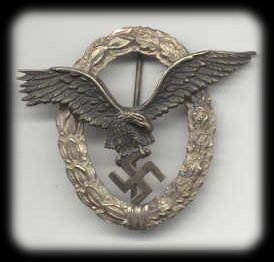
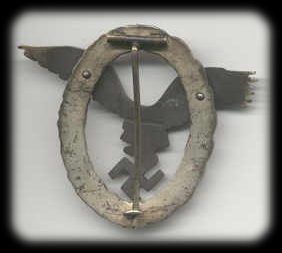
F.W. Assmann und Sohn
This firm churned out all manner of regalia for the German government. As such, their pilot badges have a slightly more “mass produced” feel. The early pieces are still of very nice quality, but they don’t compare to a Juncker or other high end maker. High quality Assmanns have distinctive die and construction characteristics. Compared to a Juncker badge, the wreath has a more concave appearance and the eagle is slightly less three dimensional. Also, the pattern on the wreath has a smooth, less “cut” appearance. The rivets are the most distinctive feature of an Assmannbadge. Often called “cupcake” rivets, their profile looks like the top of a cupcake. The rivets are also slightly countersunk and have concentric “spin” marks on them ending in a tiny nipple at the very top. This style of rivet disappeared as the war progressed. High quality Assmann badges have barrel hinges, needle pins and wire catches. They are also invariably marked with the incused, stylized “A” typical of Assmann products.
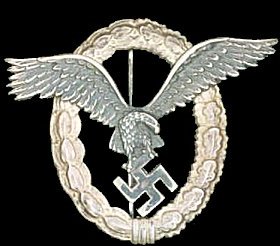
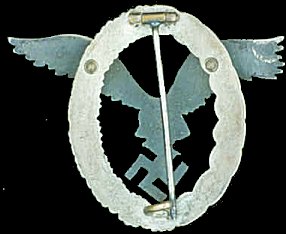
Assmann Badge


Gebruder Wegerhoff, Ludenscheid (GWL)
GWL pilot badges are perhaps the most visually distinctive. They have a unique die pattern that gives the eagle a slightly chubby look compared to other makers. The wreath is highly detailed and multi-dimensional. The back of a GWL pilot badge is what really sets it apart. As mentioned above, GWLs have block hinges and catches that look like a tiny claw formed from flat metal stock. GWL pins are the Shepherd crook type and the rivets have a distinctive countersunk appearance with a small divet in the center. The finish of a GWL pilot badge is exceptionally attractive and is what makes them a very desirable addition to any collection. The eagle is oxidized in a rich caramel-bronze color and the wreath has a very frosty silver appearance. A GWL finish is durable and has held up well over the years. High quality GWL pilot badges are always marked with the firm’s logo, the letters “GWL” enclosed in a circle. The logo has a “break” in the circle at approximately the 7 o’clock position which is probably the result of a slightly defective stamp. Like a Juncker badge, high quality GWLs command a premium on today’s market.
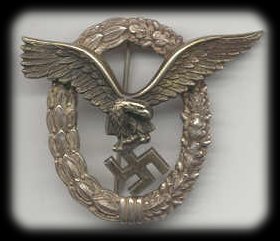
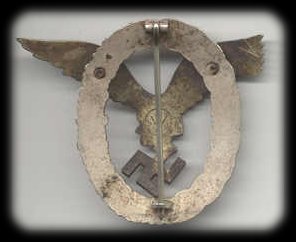
OM
Nobody knows exactly what OM stands for, but their pilot badges are very high quality and quite desirable. OM badges have a distinctive look to the talons of the eagle. While most other makers used patterns that make the eagle look like it is actually clutching the swastika in it’s talons, OM eagles have talons that look one dimensional…almost like two three pronged forks. OM badges also have a small circular cut out between the eagle’s legs. OM badges have barrel hinges and wire catches, and are deeply marked with the letters “OM” in small incuse relief script. Original OM pilot badges are very rare and valuable.
Some other original pilot badge makers are:
-
Berg
& N
- Paul Maybauer, Berlin (PM)
- MuK
Wear
The badge was worn on the upper left uniform pocket, below the Iron Cross 1st Class. Eligible to receive it were all those who completed pilot training.
Below is Walter Sumpf, who flew with KG100 and was a late war RK winner. The picture is neat because it is so wrong! He is wearing both a pilot and pilot observer badge! His Knights Cross is actually a converted Iron Cross 2nd Class.
Miscellaneous
Cloth pilot badge
The pilot badge was also authorized in a cloth sew-on version. Judging from period photos, this was a popular option. Cloth badges for enlisted personnel are done in machine woven thread, while those for officers are made ofwire bullion. Both types are most typically found with Luftwaffe Blue-grey cloth backings.
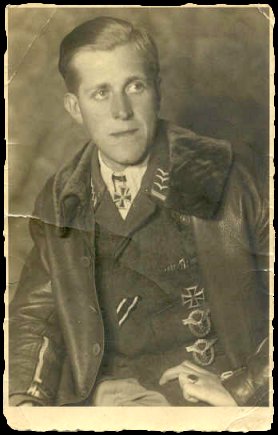
“Round wreath” pilot badge
Here we go! I’ll don my armor now. Many reference books and dealer catalogues refer to a version of the pilot badge that has a completely round wreath. Various explanations for this odd feature are often discussed. I have heard these badges referred to as prototype pieces, items made in Axis allied nations and even jet pilot badges! In reality, nobody knows for sure why these badges exist or if they are genuine. I’m a Luftwaffe nut, and have been since childhood. I have NEVER seen a photo of this badge beingworn. I’ll be the first to admit that a lack of photographic evidence isn’t necessarily a reason to condemn something, but it does make you wonder. Additionally, reproductions of “original” round wreath badges definitely exist. My advice: stick with a known maker and pattern…it is much safer. Having said that, I would love to see or hear concrete evidence which supports the originality of the “round wreath” badge. I would be especially interested in seeing period photos of one being worn.
Imperial pilot badge
Imperial era pilot badges are often seen in Third Reich period photos. Many veterans of the First World War proudly wore their Imperial flight badges, often in conjunction with a Third Reich era version. Imperial pilot badges exist in different styles according to kingdom and service. The most common type, however, is the Prussian pilot badge. The design of a Prussian pilot badge consists of the familiar oak and laurel wreath surrounding an aircraft in flight over a pastoral scene. The wreath is topped with the Imperial crown and has the image of a tied ribbon at the base. Different construction styles exist, including stamped, two piece hollow types and one piece “massive” versions. The pin construction on actual WWI era badges is of the wide, drawn variety, while badges made during the 1920s and 30s tend to have Third Reich style needle pins. Imperial pilot badges are often made of 800 silver, but also exist in higher silver grades and non-silver alloy. Imperial flight badge collecting is a fascinating field, but it suffers from lack of good reference material. Proceed with caution!
|
|
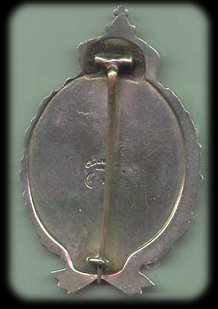 |
Axis allied pilot badges
Tradition held that German pilots were allowed to wear the aircrew qualification badges of allied nations alongside their Luftwaffe versions. This practice was especially common among German pilots serving in the Balkans, North Africa and Italy. Two examples of Axis allied pilot badges are the:
-
Italian Pilot Badge: The design for this badge consists of a long, slender, stylized eagle surmounted by a crown and clutching a fascia (bundle of sticks) in its talons. These badges can be found with a variety of maker marks, but are normally gold colored, die struck and pin backed. Period photos show that German pilots typically wore this insignia above one of their tunic pockets. As a side note, Italian pilot badges can be used to track Italy’s fortunes in WWII. After Italy’s surrender and official withdrawal from the war in 1943, some Reggia Aeronautica (Italian Air Force) pilots chose to “soldier on” with their German counterparts, while others chose to support the Allies. The pilots in the first category often snipped the Imperial crown from their pilot badge, while those in the second category left the crown, but removed the fascia (the fascia being the symbol of Mussolini’s black shirt movement). Since German military personnel were forbidden to wear Italian insignia or awards after the surrender, the Italian pilot badges worn by Luftwaffe members more often than not have the crown and fascia intact.
-
Bulgarian pilot badge: The pilot badges issued by the Kingdom of Bulgaria are, in the author’s opinion, among the most attractive aircrew insignia ever made. Of a multi-piece construction, the Bulgarian pilot badge consists of an oval, stamped, silvered front plate with a separately applied gilt eagle. The edges of the oval have a wreath pattern with an Imperial crown (also gilt) at the top and a bow at the bottom surmounted by a shield with a rampant lion motif in the center.The obverse of the badge has exceptionally fine enamel work in the form of sky blue “rays” and a red background to the crown and shield. The reverse has a very shiny, rounded silver backing plate and a screw back attachment. The example in my collection, and the other originals I have seen, have cyrillic markings in a circle on the shiny backing plate and on the brass nut for the screwback.. The Bulgarian pilot badge was typically worn on the lower left tunic pocket.
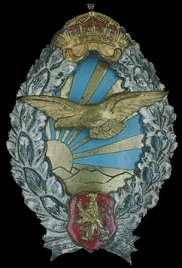 |
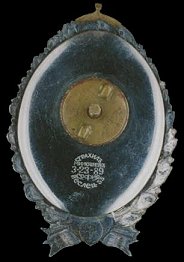 |
Cases
The pilot badge was presented in a blue hinged box with the typical spring loaded stud fastener. The interior is comprised a blue or purple silk padded lid and a blue flocked, fitted insert in the bottom. The lettering on original case s can vary slightly in wording, but is always gold in color.
Reproductions and Restrikes
This is always a difficult topic to discuss because of the new fakes that seem to constantly flood the market. The best advice I can give is to look for the characteristics associated with known original versions of the maker you seek. Needless to say, any hand cast pilot badge should be dismissed out of hand. All originals were made with heavy industrial dies. Also look for overall quality. Early pilot badges stand out in this area. In my opinion, restrikes made from original dies pose the most serious threat to the collector of Luftwaffe pilot badges. Because the original toolings are used, these badges have die characteristics identical to an original. Luckily, restrikes almost always fall down in quality or in the subtleties of construction, marking and finish. Again, if you know what an original is supposed to look like, you’re ahead of the game. Some of the more well known reproductions are:
Pfleuger & Voss:
This mark can be found on many fake badges, including Luftwaffe pilot badges. Pfleuger & Voss DID NOT make badges during the Third Reich era. These are fakes, don’t touch them.
L/58:
L/58 is the infamous LdO mark of Rudolph Souval. Souval restruck pilot badges along with numerous other items. Post war Souval pilot badges are typically executed in zinc, have the L/58 logo on the back in tiny incuse relief and have a cheap, non-standard pin and catch arrangement. Often the eagle is attached to the wreath by bent wires instead of rivets. I have also seen pilot badges matching theSouval die characteristcs executed in high quality materials. To the best of my knowledge, Souval did not make pilot badges during or before the war, so anything with Souval markings or die characteristics should be treated with great suspicion.
C.E. Juncker “SW 68”:
Beginning in the 1980s, pilot and other aircrew badges bearing an SW 68 version of the Juncker logo began to appear on the market. These badges are normally in mint condition and do not share the commonly accepted Juncker die characteristics. The known original Juncker aircrew badges I have observed DO NOT have thenumber 68 included in the SW portion of the logo. In all fairness, the jury is technically still out on these pieces. In fact, recently an experienced German collector encountered a veteran acquired example of a Juncker aircrew qualification badge that DID have the “SW 68” logo. I would still advise caution with these however.
The latest and greatest:
Recently I’ve run across a series of very disturbing pilot badges that I believe are 100% bogus. The more commonly encountered one has an eagle that is identical to the early pattern Juncker badge, ie, flat and with cut out legs. The wreath seems to be struck from some kind of a modern alloy and has a very flat, one dimensional look. Thewreath also doesn’t match the die characteristics of an original first pattern Juncker badge. The eagles on these pieces are, unlike an original Juncker, heavily oxidized and dark. The wreaths typically have an odd frosted appearance. Although the quality of these badges is exceptionally high, the pin, hinge and catch differ slightly from an original Juncker piece. These items are marked with the correct CE Juncker logo. To make matters worse, I have seen badges with eagles matching the die characteristics of other original makers attached to the SAME wreath, hinge, pin and catch! I have also seen Luftwaffe observer badges with this wreath. It is my opinion that these badges belong to a series of fakes made from high quality castings of original eagles, which are in turn attached to a universal die struck wreath. The casting captures the detail of the original and also the maker mark. The Juncker version I have seen has a slightly pitted, porous look to the entire surface of the eagle, even the edges and back. The casting has also picked up some of the heavy die marks. Be very careful of these!
|
FAKE PILOTS BADGE
|
|
|
|
|
![]()
© Copyright Wehrmacht-Awards.com LLC |
